The sun, wind, weather, and flying debris are the obvious opponents when it comes to maintaining the integrity of your roof and siding. Most of it is out of your hands – Mother Nature’s intensity and persistence eventually win out.
But there’s another formidable enemy for small buildings and your house’s exterior that you do have some control over if you’re vigilant: Pests.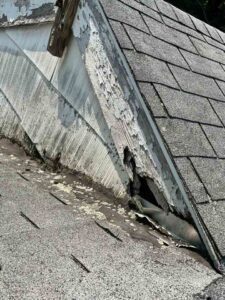
Insects and critters can cause damage to your roof and siding by chewing on them or by nesting in them. Besides making a mess of things, these nuisances can make the structure of your home unsafe.
And this, of course, can lead to costly repairs or even replacement of your roof, siding, wooden framework, or electrical wiring.
Here are some of the common adversaries to be aware of so you can help protect your home:
Termites
Termites are the classic shiver-down-your-spine pests for homeowners everywhere. Their destructive reputation is well-deserved.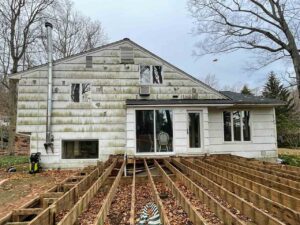
They can cause serious damage to your home by perpetually eating away at the wood that helps make up your roof and siding, including the decking and rafters. This can weaken the structure of your home and make it more susceptible to damage from weather or other pests.
Termites can also damage your home by munching their way into the foundation or walls, which can lead to cracks and leaks that in turn can compromise your roof and siding. A domino effect, if you will.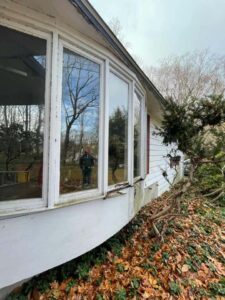
Rats and mice
They can gnaw holes in shingles, wood, and insulation, allowing moisture to enter your home. This can lead to rot and structural damage.
The waste of rats and mice can stain or discolor the material, leaving it in malodorous and undesirable shape. In addition, their nests can block gutters and drainpipes, leading to water building up and potential flooding from precipitation because of drainage disruptions.
Further (and potentially more dangerous), rodents can chew on your electrical wires. This can lead to electrical fires, or at the very least repairs from the destruction.
Squirrels, chipmunks, and raccoons
While some squirrels and chipmunks will take up residence in attics or crawlspaces, others build nests in the spaces between your home’s siding and roofing. Bad news either way.
Like rats and mice, these animals love to gnaw on any exposed wires they find, raising the possibility of shorts in the electrical system and even fires. That’s likely after they’ve chewed on your shingles, sheathing, or drywall.
And once they’re ensconced, squirrels and chipmunks will track in dirt, tree leaves, and other debris as they come and go. Speaking of “going,” squirrel urine is a smelly mess that can build up and eventually bring a foul odor into your home.
Raccoons can rip off roofing, siding, and eaves, and like to nest in attics and chimneys, so if you have gaps or holes in your roofline, better get them covered because that’s another way they can get into your home.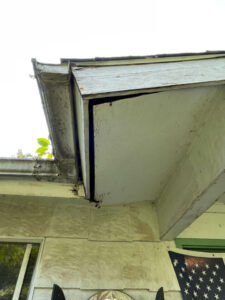
Birds
Like squirrels and chipmunks, birds are cute but widely destructive. Their claws can scratch and puncture shingles and other materials, and their beaks can peck at wood and siding; we’ve seen woodpeckers bang on vinyl siding like it’s just another grove of ash trees.
Also, their droppings can stain, discolor, or compromise your roof or siding. This is because their waste is highly acidic. Surely you’ve seen what the accumulation of their “natural resources” can do to a statue, concrete, or a paint job when it’s a couple of inches thick … think of the harm it could do to asphalt shingles or vinyl over time.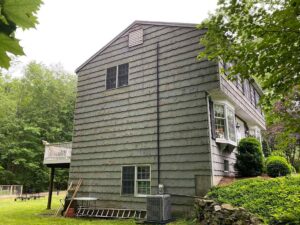
Plus, birds build nests, and the materials that compose your house’s exterior are fair game to birds to use as they see fit for their bedding. If that means tearing away some, so be it. And if those nests are built in a way that they’re covering vents, that could hinder circulation, another domino problem for sloped roofs and flat roofs alike.
Carpenter ants
Carpenter ants are able to tunnel through wood, which can weaken the structure and durability of your home.
There are several ways to prevent carpenter ants from damaging your home. First, keep trees and shrubs trimmed away from your house. Carpenter ants are attracted to wooded areas, so trimming back branches, plants, nearby crops of vegetables, and other vegetation will help discourage them from coming near your home.
Second, seal any cracks or crevices in your foundation or exterior walls. This will help prevent carpenter ants from getting inside your home. Finally, keep your kitchen and bathroom clean and free of food debris. Carpenter ants are attracted to food supplies.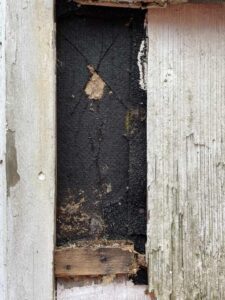
Bees, wasps, and hornets
These insects build their nests by chewing through wood and other materials. If there is any moisture involved in the process, this can weaken the structure of your roof or siding, making it more likely to be compromised. In addition, the bees’ honey can attract other undesirables such as ants and mice.
Carpenter bees tunnel into wood, which can again damage the structure of your home. In addition, their tunnels provide an entry point for water, which can lead to leaks and further damage.
Be responsible
It is important to keep an eye out for any signs of an animal or species of insects on your roof and siding. If you see any evidence, you should contact a pest control professional or a professional contractor like Gunner right away. They will be able to inspect your home and determine the best course of action to take for getting a handle on the issue and repairs.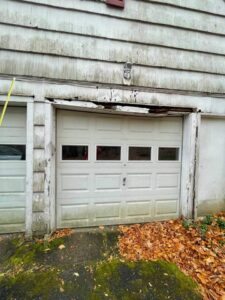
You can also take some preventative measures to help keep them off your roof and siding. For example, you can seal any cracks or gaps around your home that might commonly provide access. You can also trim back any trees or shrubs that are close to your home. This will help to keep them from being able to get to your roof and siding.
If you do find them on your roof or siding, it is important to have them removed as soon as possible. Otherwise, they could cause further damage to your home.